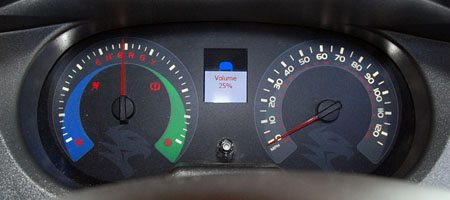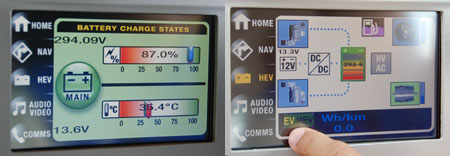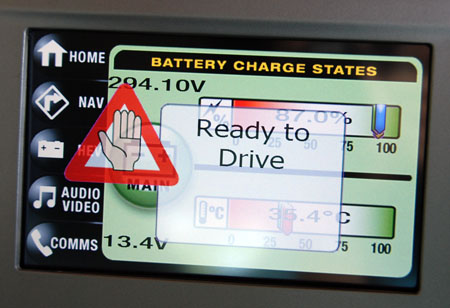|
View: 2601|Reply: 8
|
All about REEV (Range Extender Electric Vehicle) Exora - Tahun 2011/12
[Copy link]
|
|
|
DRIVEN! Proton’s Range Extender Electric Exora Prototype
November 25, 2010 at 7:12 pm
By Danny Tan

Here’s something unexpected. We’ve not only got up close and personal with Proton’s prototype Exora EV, we’ve driven it already! And this wasn’t at a Proton event, but at the iGREET (Information on Green Technology) seminar series on green technology organised by Cyberview Sdn Bhd, the landowner of Cyberjaya. Proton was invited to this sixth and last iGREET session to talk about its foray into the electric vehicle scene.
As most know by now, Proton will roll out green cars in the near future that are often dubbed as “hybrid cars” by the media. In actual fact, the cars coming our way aren’t hybrids in the mould of the Prius or Civic Hybrid, but electric cars powered solely by batteries.
Proton’s Green Project Team is working with UK-based Fraser-Nash Research, Lotus, Imperial College London and Universiti Teknologi Malaysia (UTM) on a Range Extender Electric Vehicle or REEV – Proton is currently testing the REEV Exora with and without the range extender function, because it’s just a matter of switching the engine on or off.

Some of you might wonder what a range extender is? One of the main drawbacks of an EV is the limited range, and the RE engine takes care of this by providing the battery with juice when it runs dry. So you can reach your destination safely before plugging the car in. The Chevrolet Volt also uses such a system, where its ICE engine doesn’t power the wheels. The experimental RE in the Exora EV prototype is a 400 cc rotary engine with 50 hp. The mass production model most probably won’t come with a rotary, but the target is minimum 50 hp.
There are two electric motors powering this Exora – one for each front wheel. Each makes 35 kW to make 70 kW in total, while torque is rated at 220 Nm combined, available from rest. Proton has decided on the use of lithium polymer batteries, which is more advanced than the lithium ion variety, which is already better than the NiMH packs used in today’s hybrids. Targeted charging time from 10% to full is 6-8 hours while fast charging takes 30 minutes. Proton is aiming for 140 km/h top speed and 140 km range on the Saga body, so we’ll presume that the figures will be slightly less for the Exora.

A charging infrastructure is obviously needed, but at least EV drivers won’t be stranded due to the range extender engine. The REEV Exora is heading to production as early as next year, although nothing is confirmed at this point, which is why we don’t have a detailed technical analysis.
What we have however, is driving impressions of the REEV Exora. We drove the exact same car that won the “Best Range Extender EV” award at the Royal Automobile Club (RAC) Future Car Challenge in England earlier this month. Read it and view the pics after the jump!
Brief driving impressions of the REEV Exora prototype

We got to drive the REEV Exora on the empty roads around the Kelab Komuniti Cyberjaya. It was a very brief run, but enough to get a feel of what it’s all about. As is the norm for EVs, starting the car is a soundless affair that one might need to get used to. Twist the key and the instrument panel will light up, as will the central LCD screen showing the battery charge state and temperature. A few seconds later, a “Ready to Drive” alert will tell you that it’s ready to roll.
Other than P, R, and N, the gear lever has two drive modes – D and S. Put it in D and the MPV rolls off silently like a big golf cart. There’s a faint whirring noise that the accompanying Proton engineer said was the fans cooling the battery. Pick up is good, as you’d expect in an EV, but speed is limited to 50 km/h in D, which should be the equivalent of ECO mode in a Prius.

Shift to S and the difference is as clear as night and day. Besides being able to hit a top speed of 140 km/h, the rate of acceleration is multiplied. I took it to around 120 km/h with ease before running out of road. An Exora with torque steer? Believe it!

These prototypes feel very far from being a finished product though. Throttle response isn’t close to immediate – back off the pedal and the car feels like it’s hit a speed limiter, step on it again and there’s a long delay before power gushes in. The steering is also heavier and less intuitive than in the standard Exora.
The rotary engine which provides the “extended range” in the name only kicks in when battery charge falls to about 30%. One can manually start the engine via the touch screen, which will change from “EV” to “HEV”. We tried, and boy was it loud. The soundproofing and exhaust system for the engine was probably not of a production grade as it was a prototype. Who knows, there could have been no exhaust system at all. Proton is still experimenting with the type of engine, but it’s most likely that the production model for consumer sales won’t feature a rotary.

How does this feel in comparison with say, the Mitsubishi i-MiEV? It all feels quite crude at the moment and is clearly work in progress, although it looks promising. They are after all just prototypes undergoing testing as we type and I’m sure the final product will be much polished.
If all things go as planned, Proton will be the first in Malaysia to sell an electric vehicle by 2012, and the targeted price of below RM100K will mean that it’s not something that’s way out of reach. Here’s something to look forward to.
http://paultan.org/2010/11/25/driven-protons-range-extender-electric-exora-prototype/
keep it up PROTON....!!!   
bila akan sampai kat pengguna Lithium Ion Air batteries (tahan sehingga 1000Kms per charge) atau batri Ni-iron, Li titanate yg boleh guna pakai hingga 20 tahun?  |
|
|
|
|
|
|
|
|
|
|
|
agak agak berapa reger dia nanti ek ? walaupun dah kata below 100K tapi tak tau lagi berapa. 99K pun still below 100K lagi tu.  |
|
|
|
|
|
|
|
|
|
|
|
|
sekali charge berape agaknye Watt power die pakai? boleh juga budget bil letrik kat umah |
|
|
|
|
|
|
|
|
|
|
|
awat nmpk lowered sgt blakang..taruk bateri byk ka? |
|
|
|
|
|
|
|
|
|
|
|
nape meter buruk sangat |
|
|
|
|
|
|
|
|
|
|
|
nape meter buruk sangat
al-asil Post at 30-11-2010 12:03  |
|
|
|
|
|
|
|
|
|
|
|
menariknya kete ni.....meter buruk ka apa ka...janji teknologi bagus..takpe...
bukan nak tengok sgt meter tu..bosan2 nanti leh tukar meter koso  |
|
|
|
|
|
|
|
|
|
|
|
"simpan kat atas" Protong!!  |
|
|
|
|
|
|
|
|
|
|
|
sama gak.....! go proton...! go....!  |
|
|
|
|
|
|
|
|
|
| |
|